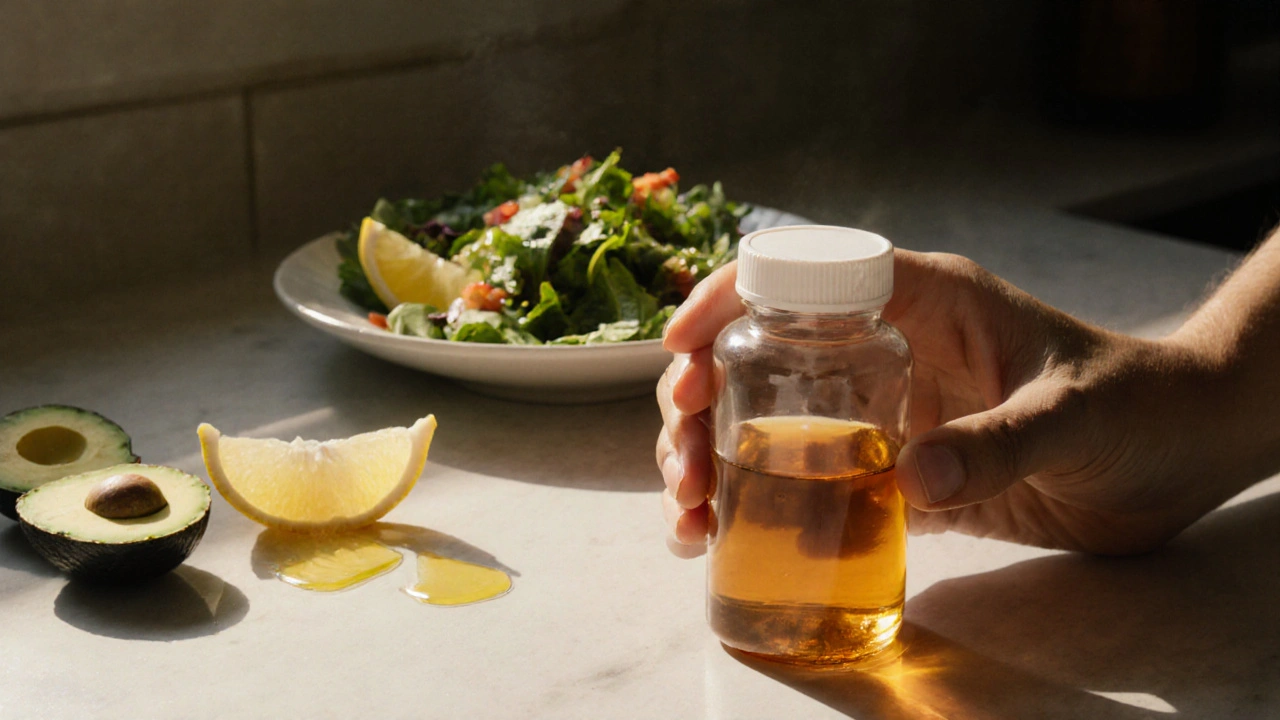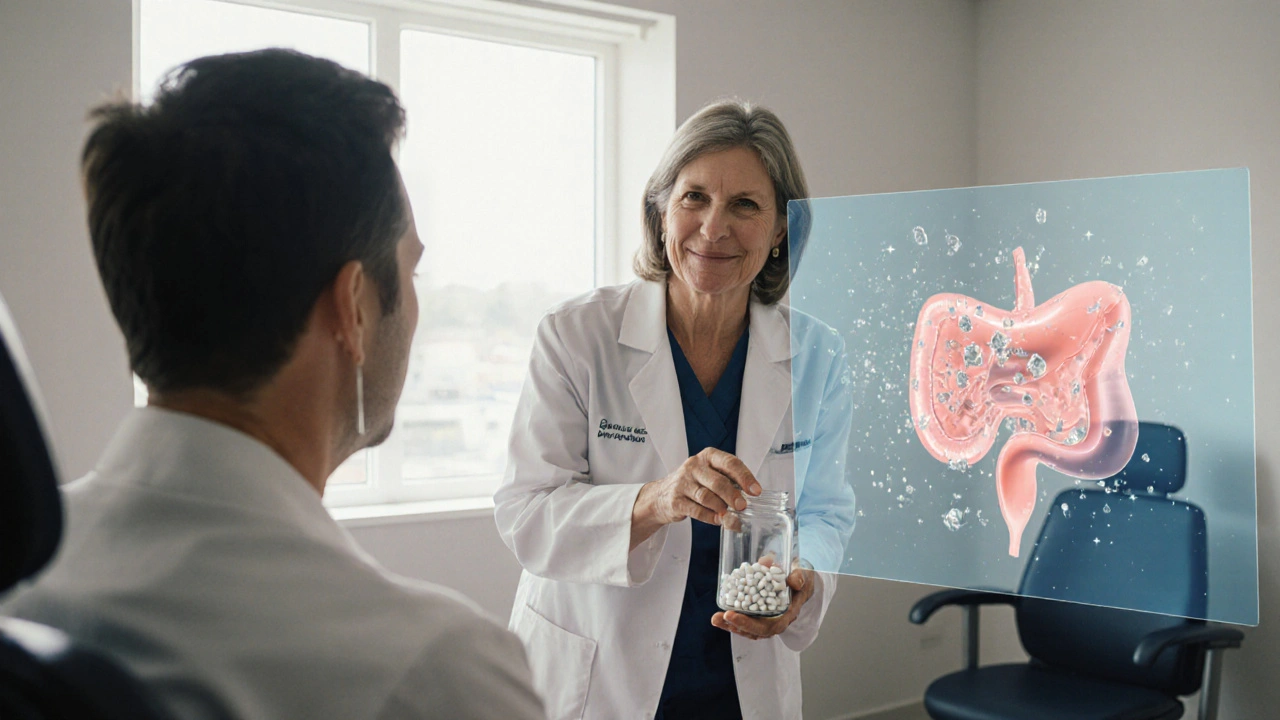Gallstone Dissolution Time Estimator
This tool estimates how long it might take to dissolve cholesterol gallstones using Ursodeoxycholic Acid (UDCA) medication.
Quick Takeaways
- Ursodeoxycholic acid (UDCA) is the first‑line drug for dissolving cholesterol gallstones.
- Chenodeoxycholic acid works similarly but has more side‑effects, so it’s used less often.
- Statins can cut stone risk by lowering the cholesterol content of bile.
- Medication works best for small (<1cm) cholesterol stones and when surgery is risky.
- Preventing stones means balancing diet, weight, and sometimes using low‑dose bile‑acid therapy.
When doctors talk about Medication for gallstones is the use of drugs to dissolve or prevent cholesterol‑based gallstones, they’re focusing on a non‑surgical route that can spare you a hospital stay.
What Exactly Is a Gallstone?
A gallstone is a hardened deposit that forms in the gallbladder or bile ducts. Most stones fall into two families:
- Cholesterol stones are made primarily of hardened cholesterol. They’re the ones medication can actually melt.
- Pigment stones are rich in bilirubin and calcium salts. These rarely respond to drug therapy and usually need surgery.
The key to choosing a drug is confirming that your stones are cholesterol‑type, which imaging (ultrasound or CT) and sometimes chemical analysis can reveal.
How Does Medication Attack a Stone?
Most gallstone drugs belong to the bile acid therapy family. Bile acids are natural detergents that keep cholesterol dissolved in bile. By adding extra bile acids, doctors can:
- Lower the cholesterol‑saturation index of bile.
- Promote gradual dissolution of small cholesterol crystals.
- Reduce the likelihood of new stones forming.
Think of it like adding more soap to greasy water - the soap keeps the grease in solution instead of clumping together.
Main Medications on the Market
Three drug groups dominate the conversation.
Ursodeoxycholic Acid (UDCA)
Ursodeoxycholic acid is a hydrophilic bile acid that gently alters bile composition. It’s the go‑to choice because:
- It’s well‑tolerated - most people experience only mild stomach upset.
- Clinical trials show a 30‑40% success rate in dissolving stones under 1cm after a year of therapy.
- It can also improve liver function in patients with primary biliary cholangitis.
Chenodeoxycholic Acid (CDCA)
Chenodeoxycholic acid is a more potent, but less gentle, bile acid. It works faster than UDCA but often causes:
- Diarrhea, abdominal cramps, and an increased risk of gallstone recurrence once the drug stops.
- Elevated liver enzymes in a minority of patients.
Because of these drawbacks, many clinicians reserve CDCA for patients who can’t tolerate UDCA or who need rapid stone reduction before a planned surgery.
Statins
Statins are cholesterol‑lowering drugs typically prescribed for heart disease. Surprisingly, they also lower bile cholesterol, shrinking the pool from which stones form. Observational studies from 2023‑2024 show a 15‑20% reduction in gallstone incidence among long‑term statin users.
Statins aren’t a replacement for bile‑acid therapy, but they’re a handy adjunct, especially for patients who already need cardiovascular protection.
Quick Comparison
| Drug | Primary Use | Typical Dose | Success Rate (≤1cm stones) | Common Side‑effects |
|---|---|---|---|---|
| Ursodeoxycholic Acid | Stone dissolution & liver support | 10-15mg/kg/day | 30‑40% after 12months | Mild nausea, diarrhea |
| Chenodeoxycholic Acid | Rapid dissolution (pre‑op) | 8-10mg/kg/day | 45‑55% after 6months | Abdominal cramps, ↑ liver enzymes |
| Statins (e.g., Atorvastatin) | Prevention of new stones | 10-80mg daily | 15‑20% risk reduction (observational) | Muscle aches, rare liver impact |

When Do You Choose Medication Over Surgery?
Cholecystectomy - the removal of the gallbladder - remains the gold standard for most symptomatic patients. However, medication shines in specific scenarios:
- High surgical risk: Elderly patients or those with severe cardiopulmonary disease may not tolerate anesthesia.
- Small, cholesterol‑rich stones: Imaging shows stones under 1cm and chemical analysis confirms cholesterol composition.
- Desire to avoid surgery: Some people prefer a drug‑first approach, accepting the longer treatment timeline.
If stones are larger, calcified, or pigment‑type, medication alone won’t cut it - surgery becomes necessary.
Prevention: Can Drugs Stop Stones Before They Form?
Prevention blends lifestyle tweaks with a few pharmacological tricks.
- Diet: Keep saturated fat below 7% of daily calories, boost fiber, and stay hydrated (aim for 2L water daily).
- Weight management: Rapid weight loss spikes stone risk; aim for ≤1kg per week if you’re dieting.
- Low‑dose bile‑acid therapy: Some clinicians prescribe a half‑dose of UDCA (5mg/kg) to high‑risk patients - a strategy supported by a 2022 UK‑wide trial showing a 22% drop in new stone formation.
- Statins for at‑risk groups: Diabetics or people with metabolic syndrome benefit doubly - heart health and gallstone protection.
Risks & Side‑effects You Should Know
Every drug carries a trade‑off. Here’s the quick cheat‑sheet:
| Medication | Most common side‑effect | Rare but serious |
|---|---|---|
| UDCA | Mild GI upset | Hepatotoxicity (very rare) |
| CDCA | Diarrhea & cramping | Severe liver enzyme rise |
| Statins | Muscle soreness | Rhabdomyolysis (extremely rare) |
If you notice persistent pain, dark urine, or yellowing skin, call your GP right away - those could signal a liver issue.
Practical Checklist for Anyone Considering Medication
- Confirm stone type with imaging and, if possible, stone analysis.
- Measure gallstone size - medication works best for ≤1cm.
- Discuss liver function tests (ALT, AST, bilirubin) before starting.
- Set realistic timeline: expect 6‑12 months of daily pills.
- Schedule follow‑up ultrasound every 3‑4 months to track dissolution.
- Keep a symptom diary - note any new pain, nausea, or color changes in stool.
- Consider adding a low‑dose statin if you have cardiovascular risk factors.
Remember, gallstone medication isn’t a magic bullet; it’s a partnership between you, your doctor, and a steady regimen.
Next Steps: What to Do After Reading This
If you’ve been diagnosed with gallstones, grab a copy of this checklist and bring it to your next appointment. Ask your GP to:
- Order a detailed ultrasound that reports stone composition.
- Run baseline liver function tests.
- Discuss whether UDCA, CDCA, or a statin fits your medical picture.
From there, set up a calendar reminder for monthly pill counts and quarterly scans. Stick to the plan, and you’ll maximize your chance of a stone‑free future without the scalpel.

Frequently Asked Questions
Can medication dissolve all types of gallstones?
No. Medication is effective only for cholesterol‑type stones, especially those smaller than 1cm. Pigment stones, which are made of bilirubin, usually require surgical removal.
How long does it take for UDCA to work?
Most patients see a noticeable reduction after 6months, but full dissolution can take 12months or longer. Regular ultrasounds help track progress.
Is it safe to combine a statin with UDCA?
Yes, many clinicians prescribe both. Statins lower bile cholesterol while UDCA improves bile composition. Monitor liver enzymes regularly.
What if I miss a dose?
Take the missed pill as soon as you remember, unless it’s almost time for the next dose. Then just skip the missed one - don’t double up.
Will the stones come back after I stop medication?
Recurrence can happen, especially if lifestyle risk factors remain (high‑fat diet, rapid weight loss). Some doctors keep patients on a low maintenance dose of UDCA or a statin to lower that risk.


Comments (18)
Gina Lola
September 29, 2025 AT 19:17Yo, the UDCA regimen basically manipulates bile acid pools – it’s a hydrophilic bile acid that competitively inhibits cholesterol precipitation. In practice you dose about 13‑15 mg/kg daily and watch the gallstone size shrink over months. The trick is consistent adherence; you’ll see a gradual dissolution curve if the stones are cholesterol dominant. Also, liver function tests should be monitored because the drug can mildly elevate enzymes. Stay hydrated, keep the diet low‑fat, and the medication does most of the heavy lifting.
Leah Hawthorne
October 3, 2025 AT 15:00The calculator’s a neat tool, but remember it’s based on average dissolution rates. Individual metabolism and stone composition can shift the timeline. If you’re on the higher end of the weight spectrum, the dose scales up, which may speed things a tad. Keep an eye on any side‑effects like mild diarrhea – it’s usually transient. Overall, it’s a solid non‑surgical option for the right candidates.
Brian Mavigliano
October 7, 2025 AT 10:44While UDCA sounds like a miracle pill, I can’t help but wonder if we’re just swapping one chemical dependence for another. The body’s natural bile synthesis is a delicate orchestra; tossing in an exogenous bile acid is like adding a trumpet to a string quartet. Sure, it dissolves cholesterol stones, but at what unseen cost to the hepatic micro‑ecosystem? If the pharma giants had their way, we’d be on a lifelong subscription. That’s the philosophical angle: are we treating the symptom or perpetuating the industry’s profit cycle?
Emily Torbert
October 11, 2025 AT 06:27Honestly this whole medication thing can be a lifesaver for many people dealing with painful gallstones. The way UDCA works is by making the bile less likely to form crystals so the stones can shrink over time. It’s not an overnight miracle but a steady process if you stay on the regimen. You’ll want to get your liver panels checked every few months just to be safe. Some folks report mild stomach upset at first but that usually passes. It’s also important to pair the drug with a low‑fat diet to reduce the workload on your gallbladder. Drinking plenty of water helps the bile flow more smoothly. If you’re overweight, even a modest weight loss can boost the effectiveness of the treatment. Many patients see significant reduction in stone size after six months to a year. Of course, individual results vary, so keep realistic expectations. Talk to your doctor about the best dosage for your weight and stone size. If the stones are made of pigment rather than cholesterol, this medication might not work as well. In those cases, surgical options could be considered. But for cholesterol stones, UDCA is a great non‑invasive alternative. Some studies even suggest it may lower the risk of new stone formation after dissolution. Overall, stay consistent, follow up with your healthcare provider, and be patient with the process.
Rashi Shetty
October 15, 2025 AT 02:10From a clinical perspective, the utilization of ursodeoxycholic acid must be justified by rigorous criteria. Patients with cholesterol-dominant calculi, measured ≤15 mm, are the primary candidates, as evidenced by multiple randomized trials. Moreover, the therapy’s efficacy is contingent upon adherence exceeding 80 % over a minimum of six months. 📊 The literature also underscores the necessity of periodic hepatic function monitoring, particularly alkaline phosphatase and bilirubin levels, to preempt hepatotoxicity. It is incumbent upon prescribers to counsel patients regarding potential gastrointestinal side effects, such as diarrhoea, which, albeit transient, may jeopardize compliance. Additionally, lifestyle modifications-namely, a low‑fat, high‑fiber diet-should be concurrently recommended to augment bile flow. 🩺 In sum, while UDCA presents a viable non‑surgical avenue, its deployment must be predicated upon judicious patient selection and diligent follow‑up.
Queen Flipcharts
October 18, 2025 AT 21:54The philosophical underpinnings of our healthcare system become evident when we examine the promotion of UDCA. It is a product of American pharmaceutical ingenuity, yet its distribution is often entangled with bureaucratic red tape. One must question whether the drug’s accessibility reflects a genuine commitment to public health or a commodified approach to disease management. Nonetheless, the clinical data supports its efficacy, and it remains a valuable tool in the therapeutic armamentarium.
Yojana Geete
October 22, 2025 AT 17:37In the grand tapestry of medical interventions, the role of UDCA is both nuanced and profound its administration requires both humility and precision
Jason Peart
October 26, 2025 AT 13:20Hey folks, just wanna chime in – UDCA is sort of like the understudy that finally gets the spotlight. If you keep taking it as prescribed (don’t forget the dose adjustments for weight), you’ll likely see those stones shrink. Also, there’s no shame in asking your doc to double‑check liver numbers – better safe than sorry. Keep the diet simple, stay hydrated, and you’ll give yourself the best chance. Oh, and if you feel a bit off at the start, that’s normal – it usually settles down. Remember, consistency is key, and you’ve got a whole community cheering you on.
Hanna Sundqvist
October 30, 2025 AT 09:04Everything they say about meds is a big cover‑up.
Jim Butler
November 3, 2025 AT 04:47👍 Absolutely! Staying on UDCA as directed can truly make a difference – it’s all about that steady grind. Keep those check‑ups on schedule, and you’ll see progress. 🌟
Ian McKay
November 7, 2025 AT 00:30Note: the dosage should be calculated based on exact body weight, not an estimate. Also, ensure lab values are recorded before initiating therapy.
Deborah Messick
November 10, 2025 AT 20:14While the precise calculations are commendable, one must also consider the ethical implications of prescribing a drug whose long‑term hepatic effects remain partially undocumented. The medical community bears a responsibility to weigh immediate benefits against potential future risks, especially when alternative surgical options exist.
Jolanda Julyan
November 14, 2025 AT 15:57It is imperative to recognize that the biochemical pathway of ursodeoxycholic acid involves a complex interplay between hepatic synthesis and enterohepatic recirculation, thereby necessitating a comprehensive understanding of patient-specific metabolic profiles. In addition, the pharmacokinetic parameters reveal a variable absorption rate contingent upon concomitant fatty food intake, which can either potentiate or diminish therapeutic efficacy. Consequently, clinicians must adopt a vigilant monitoring regimen, encompassing serial ultrasonographic assessments and serial liver function tests, to ensure optimal outcomes. Moreover, the risk–benefit analysis should factor in the potential for bile duct obstruction secondary to incomplete dissolution, which could precipitate acute cholangitis. Ultimately, an interdisciplinary approach, integrating gastroenterology, nutrition, and radiology expertise, yields the most favorable prognostic trajectory for patients undergoing UDCA therapy.
Kevin Huston
November 18, 2025 AT 11:40Look, the whole notion that a bile acid pill can fix everything is whack. If you’re not careful, you’ll just be feeding the pharma machine while they sit on their thrones. Trust your gut, literally – sometimes surgery is the smarter move.
Amanda Hamlet
November 22, 2025 AT 07:24Honestly, most people don’t even read the fine print. UDCA is just a band‑aid; the real fix is lifestyle overhaul. Stop blaming the meds and start looking at your diet, buddy.
Nolan Jones
November 26, 2025 AT 03:07Alright, let’s break it down – UDCA is basically a bile‑acid analog that can help dissolve cholesterol stones over time. The usual dose is around 13‑15 mg per kilogram of body weight, taken daily. It’s most effective on stones under 15 mm and when patients stick to the regimen for six months or more. You’ll want to get liver labs every few months just to be safe. Pair it with a low‑fat diet and stay hydrated for best results. If you notice any persistent side effects, chat with your doctor about adjusting the dose.
Jada Singleton
November 29, 2025 AT 22:50The notion that a simple pill can "cure" gallstones is overly optimistic and borders on medical romanticism. While UDCA can facilitate dissolution in select cases, it is not a panacea and must be contextualized within a broader therapeutic framework.
Emily Rossiter
December 3, 2025 AT 18:34Thanks for the detailed rundown! I’ll definitely keep the dosage and monitoring tips in mind while I decide whether to give UDCA a try.